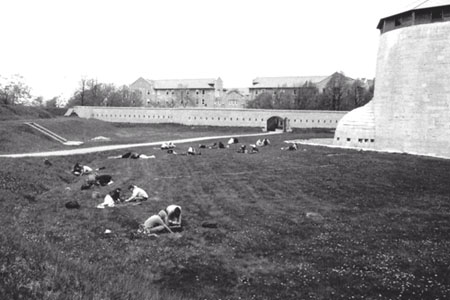 The 2005 excavation marked the tenth season of “Can You Dig It?”© Summer Archaeology Program and included a total of 115 students! 47 participated through Queen’s E=MC² program, and 68 through the “Can You Dig It?”© program.
The 2005 excavation marked the tenth season of “Can You Dig It?”© Summer Archaeology Program and included a total of 115 students! 47 participated through Queen’s E=MC² program, and 68 through the “Can You Dig It?”© program.
The 2005 archaeological investigations were continued at Fort Frederick on the grounds of the Royal Military College of Canada. The excavations focused primarily on some of the elements of the War of 1812 period, but 1846 Tower period features were also investigated. Work was concentrated on the more southerly officers’ quarters, a barracks that burned in 1816, drainage patterns and systems, the relationship between the 1812 blockhouse and Tower period ditch construction, and the canteen, northeast picket and Tower period latrine. A total of 12 sub-operations and 23 test pits were excavated in 2005.
Of the artifacts found, creamware ceramics, which date to the 1760s to 1820s are the earliest type of ceramic seen on the site, as well as a small amount of pearlware ceramics dating between the 1780s and 1830s, and are concentrated towards the south end of the site. Similarly, brick and mortar fragments were also concentrated at the south end. By contrast, evidence of the pavé surface seems to have been located east of the Tower ditch and to the southwest of the Royal Artillery Barracks. Evidence of two cobble drains was also encountered in 58Z and 71L and relate to the Tower period. Overall, the earlier artifacts and building materials are concentrated towards the south, while the pavé is closer to the Tower ditch and a structure that may have survived into the early Tower period.
After three seasons, 2003, 2004 and 2005, of fieldwork at the site of Fort Frederick, RMC it has been possible to archaeologically examine several areas of the War of 1812 period fort and the 1846 tower. It is clear that although no abundant physical structures remain from the War of 1812 period, that there are undisturbed cultural deposits and building foundations at the site. There are also intact deposits relating to the construction and occupation of the 1846 Martello Tower and its associated structures. The majority of the material culture was recovered from the Tower period latrine, the area between the War of 1812 period canteen and guardhouse, with smaller amounts from other areas. Much of the material from the latrines was determined to date to the early College period. Small amounts from other locations appear to be of an earlier date including the War of 1812 period and subsequent Tower period.

 The 2005 excavation marked the tenth season of “Can You Dig It?”© Summer Archaeology Program and included a total of 115 students! 47 participated through Queen’s E=MC² program, and 68 through the “Can You Dig It?”© program.
The 2005 excavation marked the tenth season of “Can You Dig It?”© Summer Archaeology Program and included a total of 115 students! 47 participated through Queen’s E=MC² program, and 68 through the “Can You Dig It?”© program.